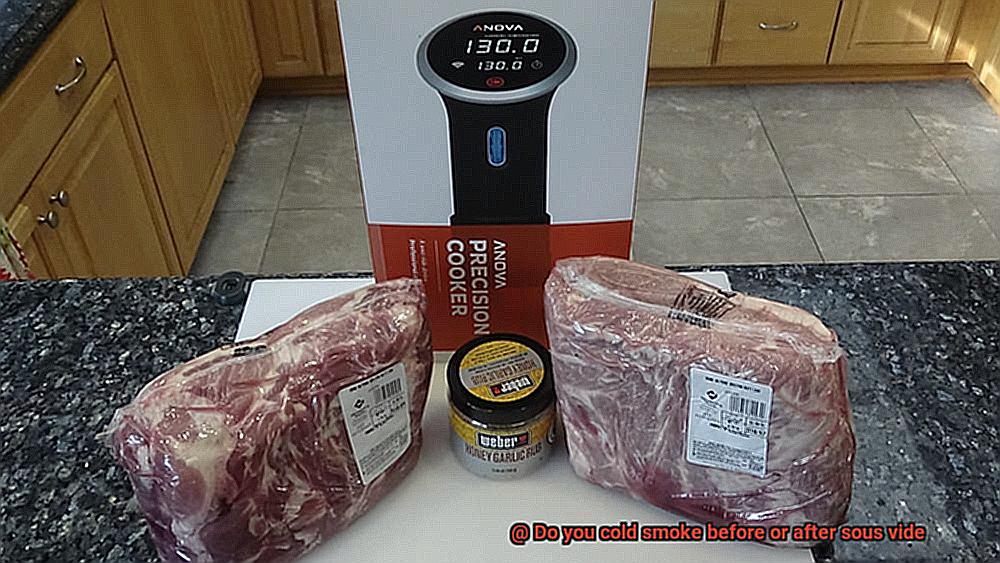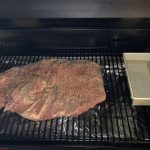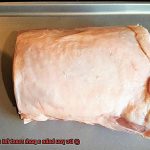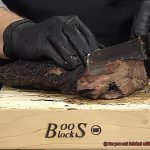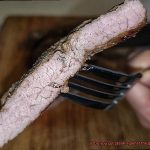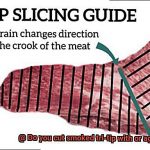Are you a foodie who loves to experiment with different cooking techniques? Do you want to create delicious dishes that are bursting with flavor and leave your guests wanting more? If so, then you’ve probably heard about cold smoking and sous vide cooking.
Cold smoking involves exposing food to smoke at temperatures between 20°C and 30°C, while sous vide is a French cooking method that involves vacuum-sealing food in a bag and cooking it at a constant low temperature in a water bath.
Now, the big question on everyone’s mind is whether to cold smoke before or after sous vide. This question has sparked debate among chefs and cooking enthusiasts for years, but fear not – we’re here to help.
Our guide will take you through everything you need to know about both techniques, from smoking equipment and cooking times to temperature ranges. We’ll also explore the benefits of each technique and show you how to create mouthwatering meals that combine the unique flavors of smoke and sous vide cooking.
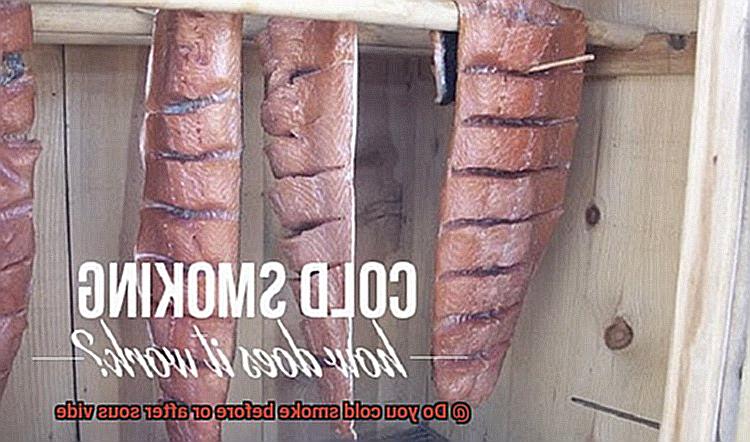
Whether you’re an experienced chef or a home cook looking to add some extra pizzazz to your dishes, this guide is for you. So sit back, relax, and let’s dive into the world of cold smoking and sous vide cooking to finally answer the age-old question: do you cold smoke before or after sous vide?
Contents
What is Cold Smoking?
Imagine savoring a perfectly cooked steak with a mouthwatering smoky flavor that lingers on your taste buds. This is exactly what cold smoking can achieve, without actually cooking the meat. Cold smoking is an ancient preservation technique that has evolved into a culinary art form used to enhance the flavor of various foods, including meat, fish, cheese, and vegetables.
The process involves exposing food to smoke at low temperatures between 68-86°F (20-30°C) for an extended period of time. The smoke infuses a deep, rich flavor into the food while also removing moisture from the surface for longer shelf life. To achieve this, a smoker that produces smoke without heat is necessary. This can be done by using soaked wood chips or sawdust placed on a tray within the smoker and lit up, producing smoke without generating any heat.
Cold smoking has been utilized for centuries as a means of preserving food in areas with cold climates where refrigeration was not available. Today, it is still used to extend shelf life while adding that distinct smoky flavor. However, it’s essential to note that cold smoking does not cook food and should not be used as the primary method of preparing meat or fish. Instead, it is best paired with other cooking methods like sous vide or grilling.
Cold smoking is a versatile technique with endless possibilities. It’s perfect for adding flavor to foods without sacrificing texture or moisture and works well with various types of food. Whether you’re smoking salmon or cheese, experimentation with different types of wood chips and smoking times can produce unique flavors.
So, when deciding whether to cold smoke before or after cooking your meats, personal preference and the type of meat you are cooking will guide you. For those seeking a stronger smoky flavor, cold smoking before cooking is recommended. However, if you prefer a more subtle smoky flavor, cold smoking after cooking is ideal.
What is Sous Vide Cooking?
This revolutionary culinary technique involves vacuum-sealing food in a bag and cooking it in a water bath at a precisely controlled temperature for an extended period. But what makes this method so special?
First, Sous Vide cooking produces perfectly cooked food every time. With the low temperature used in this method, you can say goodbye to overcooked or undercooked meals, and since the temperature is precisely controlled, there’s no guessing game involved.
Second, Sous Vide cooking seals in all the natural juices and flavors of your food. Unlike traditional methods of cooking, your meat will be tender, juicy, and packed with flavor.
Third, Sous Vide cooking is versatile. You can cook vegetables, fish, eggs, and even desserts with this method.
The term “Sous Vide” means “under vacuum” in French, and this technique was first developed in France during the 1970s. It was initially used in high-end restaurants but has become increasingly popular among home cooks with the development of affordable Sous Vide machines.
Pros and Cons of Cold Smoking Before Sous Vide
The debate on whether to cold smoke before or after sous vide has been a topic of discussion amongst chefs and foodies alike. As an expert on this topic, I’m here to give you the rundown of the pros and cons of cold smoking before sous vide.
Let’s start with the positives. Cold smoking before sous vide can infuse your meat or fish with an intense and complex smoky flavor that will elevate your dish to new heights. By exposing your protein to smoke at temperatures below 90°F (32°C) before cooking sous vide, the smoke has more time to penetrate the meat or fish, resulting in a deeper, richer flavor profile that is not diluted during the cooking process. This technique can also help develop a darker, more appealing color and aroma that will tantalize your senses.
However, there are some potential drawbacks to this method that must be taken into account. The first factor that needs to be considered is food safety. Cold smoking equipment is not always regulated for food safety, which means bacteria may be present if it’s not cleaned and maintained properly. To ensure your food remains safe to eat, it’s important to take extra precautions when cold smoking.
Another issue is that cold smoking can cause the surface of your meat or fish to harden, making it challenging for the sous vide cooking process to penetrate evenly. This can result in unevenly cooked food, which is never ideal.
Pros and Cons of Cold Smoking After Sous Vide
Before you get started, let’s dive into the pros and cons of this cooking method.
On the plus side, cold smoking after sous vide allows for a deeper flavor infusion. The smoke is able to penetrate the meat more thoroughly, resulting in a stronger and more complex flavor profile. And let’s not forget about the aroma – cold smoking can give your meat a unique and enticing smoky scent that will have your taste buds dancing with joy.
However, there are some potential drawbacks to keep in mind. One concern is the risk of over-smoking the meat. If you’re not careful, the smoke can become too overpowering and ruin the overall flavor. Additionally, cold smoking can increase the cooking time and temperature, which could affect the texture and moisture levels of the meat.
But perhaps the most important consideration is food safety. After sous vide, it’s crucial to chill your meat immediately before exposing it to smoke to prevent any bacterial growth. Using a food-grade plastic bag or wrap during smoking is also recommended to protect the meat from harmful contaminants.
To summarize, here are some key factors to consider when cold smoking after sous vide:
Pros:
- Deeper flavor infusion
- Unique and enticing aroma
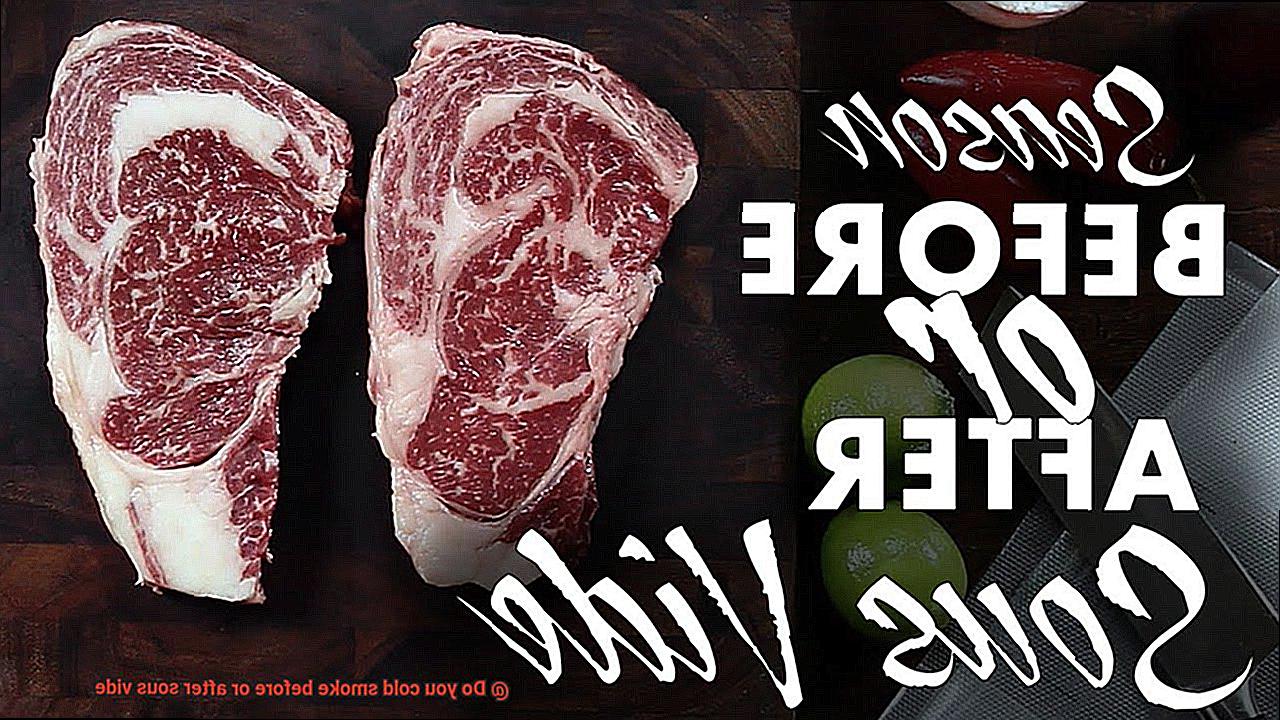
Cons:
- Risk of over-smoking
- Increased cooking time and temperature
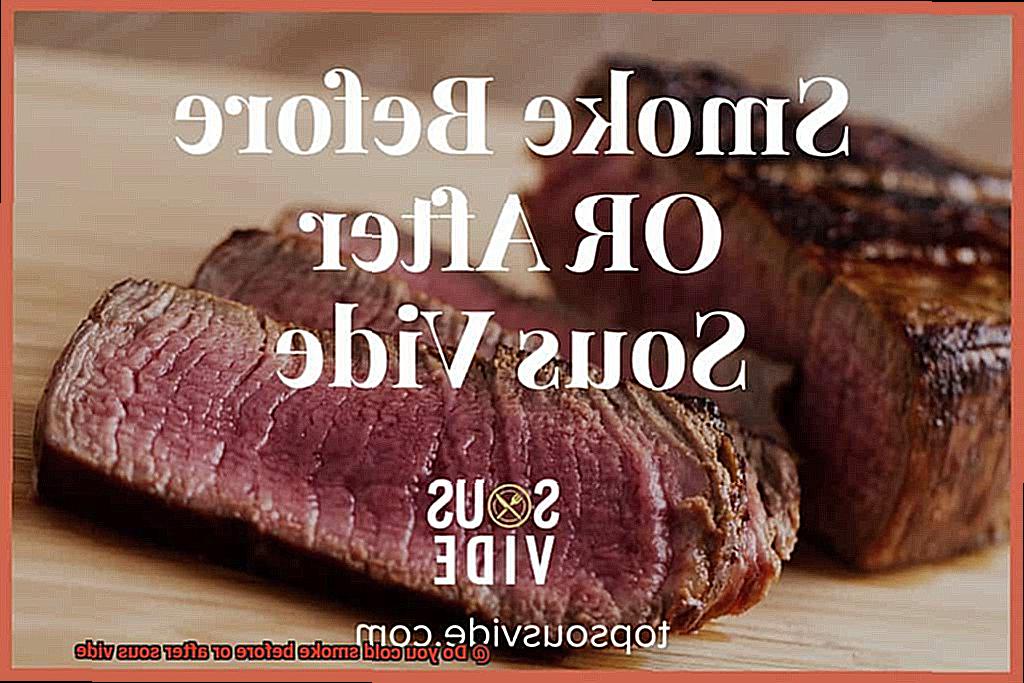
Food Safety Precautions:
- Chill meat immediately after sous vide
- Use food-grade plastic bag or wrap during smoking
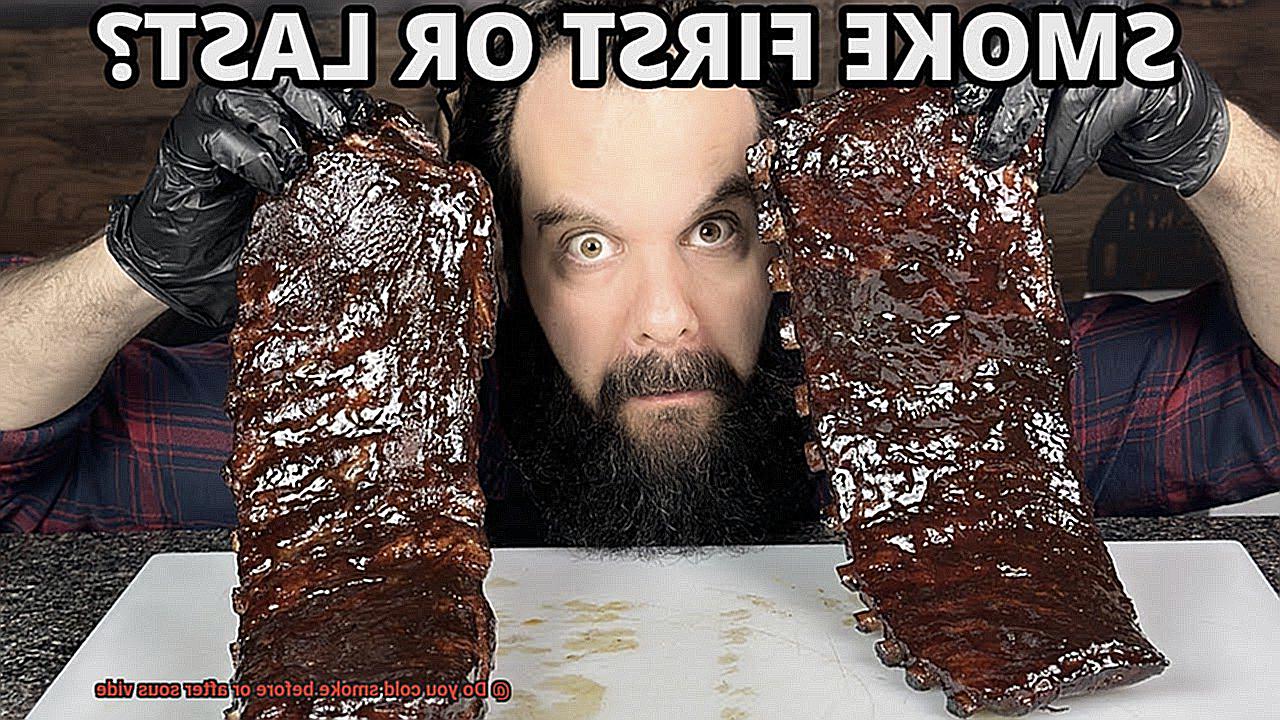
Best Practices for Cold Smoking Before or After Sous Vide
The added layer of smoky complexity will impress even the most discerning palates. But before you get started, let’s review the best practices for achieving the perfect result.
Timing is Crucial
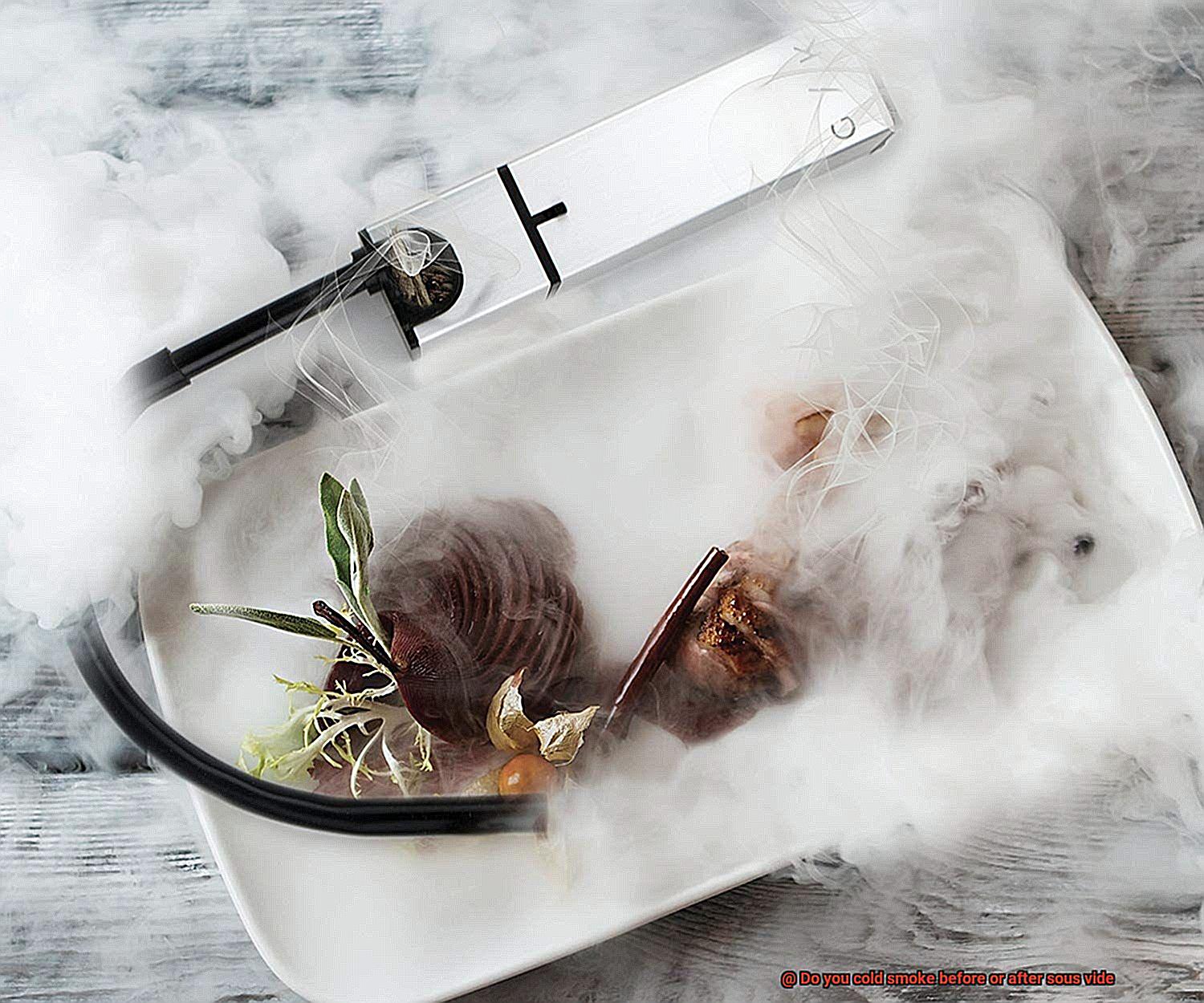
Cold smoking should only be done before cooking sous vide. This is because cooking the meat first can destroy the delicate smoke flavors. If smoking before sous vide, it’s recommended to smoke for 30 minutes to an hour before vacuum sealing and cooking.
This allows enough time for the smoke to infuse the meat without overpowering it. Cold smoking should also be done at a low temperature (below 100°F) to avoid cooking the meat prematurely.
If smoking after sous vide, do it immediately after cooking and before searing while the meat is still cold. This ensures that the smoke flavor has time to penetrate the meat without overcooking it. As with pre-sous vide smoking, use a cold smoker and monitor the temperature closely.
Choose Your Wood Wisely
The type of wood chips used will greatly impact the final flavor of the meat. Hickory, applewood, and mesquite are popular options that complement various types of meat. It’s important to choose high-quality wood chips that pair well with your specific dish.
Safety First
As with any raw meat handling, practice proper food safety measures when cold smoking. Chill your meat promptly after smoking and only use food-grade materials during the process.
Types of Meats Suitable for Cold Smoking Before or After Sous Vide
Cold smoking and sous vide cooking are two popular techniques that can help you achieve this. However, not all meats are suitable for these methods. Let’s dive deeper into the different types of meats that can be cold smoked before or after sous vide.
Salmon
Thanks to its oily texture, salmon is an ideal candidate for cold smoking. When cold smoked after sous vide, it absorbs the smoky flavor without becoming overwhelmed by it. You’ll love the extra layer of flavor and texture this process adds to your salmon.
Beef
Beef is a versatile meat that can be smoked before or after sous vide. However, it’s crucial to choose the right cut of beef for cold smoking. Smoking beef after sous vide ensures that the meat stays moist and tender while absorbing the smoky flavor.
Pork
Pork belly is a popular choice for cold smoking before sous vide. Smoked bacon is a great example of how delicious pork can be when prepared using this method. The low temperature of the smoke allows the bacon to take on a subtle smoky flavor without becoming too overpowering.
Chicken
Poultry can also be smoked before or after sous vide. However, due to food safety concerns, it’s important to fully cook poultry before cold smoking or use a food-safe cure. Smoking poultry after sous vide with a shorter smoking time can help avoid overcooking and ensure that the meat stays juicy and flavorful.
Lamb
Lamb is another meat that can benefit from cold smoking before or after sous vide. The smoky flavor complements the natural sweetness of lamb and adds an extra layer of depth to the dish.
Experimenting with Different Types of Meat and Smoked Times
Adding a smoky flavor to meat dishes can elevate them to a whole new level. However, achieving the perfect balance between smoke flavor and tenderness requires experimentation with different types of meat and smoked times. Here are five factors to consider when experimenting with smoking meats.
Types of Meat
Different types of meat require different smoking times to achieve optimal flavor and texture. Beef may require a longer smoking time than chicken or fish due to its thickness, while fattier meats like pork belly may absorb smoke more readily than leaner cuts like chicken breast. It’s essential to experiment with different types of meat to find what works best for you.
Desired Level of Smokiness
The desired level of smokiness in the final dish is also an important factor to consider. Cold smoking before sous vide can result in a stronger smoke flavor, while smoking after sous vide can result in a more subtle smokiness. It’s up to the individual to determine which method they prefer based on their desired outcome.
Length of Smoking Time
The length of time the meat is smoked will also affect its final taste and texture. Leaving meat in the smoker for too long may result in an overpowering smoke flavor and dryness, while not smoking it enough may result in a lack of smoky flavor. It’s crucial to find the perfect smoked time for a particular cut of meat through trial and error.
Cold Smoking Before or After Sous Vide?
Deciding whether to cold smoke before or after sous vide ultimately comes down to personal preference and the type of meat you are cooking. Some meats, such as chicken or pork, may benefit from being cold smoked before being sous vided to add a smoky flavor.
However, other meats like beef may not require cold smoking before sous vide as their natural flavors are prominent. Keep in mind that if the meat is exposed to smoke for too long, it can become bitter.
Start Small and Keep Notes
Experimenting with different types of meat and smoked times requires patience and attention to detail. It’s best to start with small batches and adjust accordingly based on personal preference. Keeping notes on the process and results for future reference can help you remember which methods worked best for certain cuts of meat.
Ultimately, it’s up to the individual to determine their preferred method based on their desired outcome.
QL2rDi5-f2Y” >
Conclusion
As the age-old debate rages on about whether to cold smoke before or after sous vide, it’s clear that both techniques have their distinct advantages. With the right equipment, timing, and technique, you can create mouth-watering dishes that are bursting with flavor.
Cold smoking is a time-honored preservation technique that has evolved into an art form used to enhance the taste of various foods. By exposing food to smoke at low temperatures for an extended period of time, you can infuse your meat or fish with a complex smoky flavor that will take your dish to the next level. Meanwhile, sous vide cooking involves vacuum-sealing food in a bag and cooking it at a constant low temperature in a water bath.
When deciding whether to cold smoke before or after cooking your meats, personal preference and the type of meat you’re using will guide you.
Cold smoking before sous vide can provide an intense and complex smoky flavor that elevates your dish. On the other hand, cold smoking after sous vide allows for deeper flavor infusion.
It’s important to follow proper food safety measures when cold smoking and only use high-quality wood chips that complement your specific dish. Experimenting with different types of meat and smoked times requires patience and attention to detail. Keeping notes on the process and results can help you remember which methods worked best for certain cuts of meat.
In conclusion, both cold smoking and sous vide cooking have their unique benefits and can be used together to create delectable dishes that leave your guests wanting more.

